
Na [lower-alpha 1] Castelloza (fl. early 13th century) was a noblewoman and trobairitz from Auvergne.

Na [lower-alpha 1] Castelloza (fl. early 13th century) was a noblewoman and trobairitz from Auvergne.
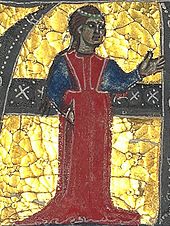
According to her later vida , Castelloza was the wife of Turc de Mairona, probably the lord of Meyronne. [1] Turc's ancestors had participated in a Crusade around 1210 or 1220, which was the origin of his name (meaning "Turk"). [1] She was reputed to have been in love with Arman de Brion, a member of the house of Bréon and of greater social rank than her, about whom she wrote several songs. [1] Her vida records her to have been "very gay", "very learned", and "very beautiful". [1] While little more is known about Castelloza’s life, her name “appears to be composed of castle and the common suffix ~os, which normally indicates quality or abundance of the noun to which it is joined. The name might then mean ‘lady worthy of a castle’ or ‘lady possessed of a castle or castles.'” [2]
As a trobairitz, Castelloza was responsible for producing poems and Cantigas (monophonic songs) throughout her career. Her works (primarily written in Galician-Portuguese) maintain the characteristics of the Canso, often referencing themes of love and courtship. The canso was a popular style among troubadours, often describing a male speaker pining after a ‘cruel female beloved.’ Castelloza continues this song structure from her perspective, expressing the challenges and conflict she, as a woman, faces. “In each of her songs, Na Castelloza takes up a posture that is simultaneously offensive and defensive: she regularly signals and defends her anomalous role as a woman who declares and serves her love by singing.” [3] This is apparent throughout her work; an example being ‘Mout avetz fach lonc estatge…’ (To Her Lover Gone Away). An excerpt translation of this poem highlights the following;
“My handsome noble-natured dear, I’ve loved you since the day you pleased me. How great a fool I am is clear. For you held back, while such love seized me That I not once have turned away. Though you repay my good with ill I’ll stand my ground and love you still, For love so has me in its sway That I now doubt my life can offer.” [4]
Castelloza maintains this perspective throughout her lasting work, describing the pain and betrayal of unrequited love while acknowledging her commitment to absolute fidelity.
Only three—perhaps four if recent scholarship is accepted—of her songs (all cansos ) survive, all without music. [5] This, however, makes her at least the second most prolific of trobairitz in terms of surviving works: only Beatriz de Dia certainly has more, with four cansos to her name. [6] The subject of all her poems is courtly love.
Compared with Beatriz de Dia, Castelloza is a more conservative poet. Her persona throughout her works is consistent and though she raises the tension between conditional and unconditional love she always remains committed to absolute fidelity. [7]
One scholar, Peter Dronke, has seen Castelloza's songs as forming a lyric cycle. [8]
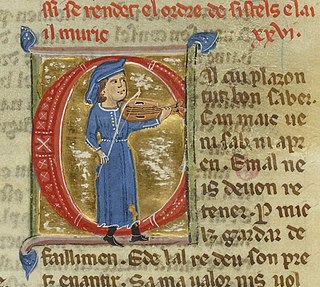
A troubadour was a composer and performer of Old Occitan lyric poetry during the High Middle Ages (1100–1350). Since the word troubadour is etymologically masculine, a female troubadour is usually called a trobairitz.

Azalais de Porcairagues or Alasais de Porcaragues was a trobairitz, composing in Occitan in the late 12th century.
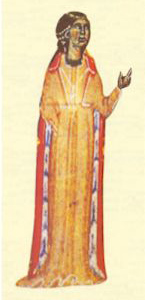
The trobairitz were Occitan female troubadours of the 12th and 13th centuries, active from around 1170 to approximately 1260. Trobairitz is both singular and plural.

Raimon de Miraval(h) (c. 1135/1160 – c. 1220) was a troubadour (fl. 1180–1220) and, according to his vida, "a poor knight from Carcassonne who owned less than a quarter of the castle of Miraval." Favoured by Raymond VI of Toulouse, he was also later associated with Peter II of Aragon and Alfonso VIII of Castile. His senhal for Raymond VI was Audiart.

The Comtessa de Dia, possibly named Beatritz or Isoarda, was a trobairitz.
Tibors de Sarenom is the earliest attestable trobairitz, active during the classical period of medieval Occitan literature at the height of the popularity of the troubadours.
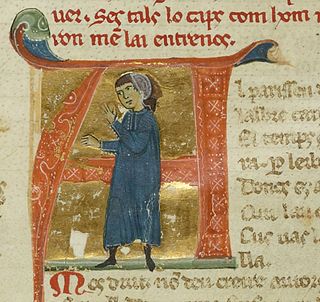
Peire Rogier was a twelfth-century Auvergnat troubadour and cathedral canon from Clermont. He left his cathedral to become a travelling minstrel before settling down for a time in Narbonne at the court of the Viscountess Ermengard. His life and career are known because his late thirteenth-century vida survives, as well as some of his works. The reliability of his vida, upon which all the details of his goings and comings are known, however, is not complete. According to it, he left the religious life to become a jongleur.

Raimon Jordan was a Toulousain troubadour and the viscount of Saint-Antonin in the Rouergue near the boundary with Quercy. His poetry was in Old Occitan.

Peirol or Peiròl was an Auvergnat troubadour who wrote mostly cansos of courtly love in the late twelfth and early thirteenth centuries. Thirty-four surviving poems written in Occitan have been attributed to him; of these, seventeen have surviving melodies. He is sometimes called Peirol d'Auvergne or Peiròl d'Auvèrnha, and erroneously Pierol.
Na Gormonda de Monpeslier or Montpelher was a trobairitz from Montpellier in Languedoc. Her lone surviving work, a sirventes, has been called "the first French political poem by a woman."
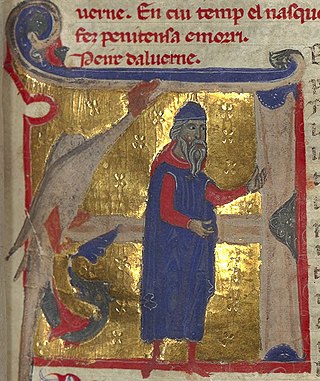
Peire d'Alvernhe or d'Alvernha was an Auvergnat troubadour with twenty-one or twenty-four surviving works. He composed in an "esoteric" and "formally complex" style known as the trobar clus. He stands out as the earliest troubadour mentioned by name in Dante's Divine Comedy.

Giraut or Guiraut de Calanso or Calanson was a Gascon troubadour in the Occitan language. Of his lyric works that remain five are cansos, two descorts, a congé, a planh, and a vers. He also wrote a mock ensenhamen entitled Fadet juglar.
Bieiris de Roman(s) was a trobairitz of the first half of the thirteenth century. Her birthplace was Romans near Montélimar. Other than her name, which includes her place of birth, nothing is known of the details of her life, which has led to a significant gap in knowledge for scholarship analyzing her work. She left behind one canso, "Na Maria, pretz e fina valors", addressed to another woman named Mary. The poem is written in the typical troubadour style of courtly love and has been consequently analyzed as a lesbian poem. Bieiris may, however, be simply writing from the masculine point of view, fully immersing herself in the masculinity of the genre. Nonetheless, the certain ascription of the poem to a woman makes it unlikely that there was any attempt to "fool" the audience: the poem is consequently emasculated. The Na Maria of the poem has even been interpreted as the Virgin Mary, and the sincerity and innocence of the lyrics do not disqualify it.

Garsenda was the Countess of Provence as the wife of Alfonso II from 1193 and the Countess of Forcalquier in her own right from 1209 and subsequently united with Provence. She was also a patron of Occitan literature, especially the troubadours, and herself wrote some lyric poetry and is counted among the trobairitz as Garsenda de Proensa. She was, in the words of her most recent editors, "one of the most powerful women in Occitan history".
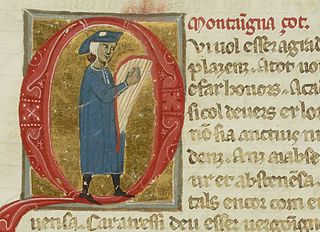
Guilhem de Montanhagol was a Provençal troubadour, most likely active in Toulouse, but known in the courts of Provence, Toulouse, Castile, and Aragon. Guilhem left behind seven cansos and six sirventes. He also left behind one tenso with Sordello and his total surviving output comes to fourteen pieces.
Ysabel or Ysabella was a 13th-century trobairitz. Almost nothing is known about her with certainty, but many conjectures have been put forward. She has been identified with:
Guillelma de Rosers, also spelled Guilleuma, Guillielma, Guilielma, or Guilhelma, was a Provençal trobairitz of the mid-thirteenth century, one of the last known trobairitz. She was originally from Rougiers but lived in Genoa for a long time, where she met Lanfranc Cigala, who wrote about her in some songs. These and Lanfranc's vida form the major source of information about her life. She is also the addressee—la flor de cortezia, the flower of courtliness—of an anonymous canso, "Quan Proensa ac perduda proeza", which bemoans her long stay in Genoa.
Arnaut Plagues or Plages was a troubadour probably from Provence.
A salut d'amor or (e)pistola ("epistle") was an Occitan lyric poem of the troubadours, written as a letter from one lover to another in the tradition of courtly love. Some songs preserved in the Italian Quattrocento and Cinquecento chansonniers are labelled in the rubrics as saluts, but the salut is not treated as a genre by medieval Occitan grammarians. The trouvères copied the Occitan song style into Old French as the salut d'amour. There are a total of nineteen surviving Occitan saluts and twelve French ones, with a Catalan examples also.
Bernart Arnaut d'Armagnac, also Bernard Arnaud, was a troubadour and from 1217 the Count of Armagnac in opposition to his brother, Gerald V, who inherited it from the childless Gerald IV. Bernart and Gerald were both sons of Bernard de Fézensaguet.